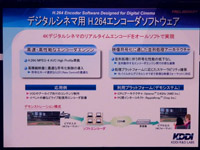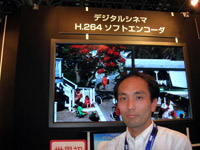World's first 4K digital cinema compatible H.264 real-time encoder software developed by KDDI R&D Laboratories
2007.11.22 UP

KDDI R&D Laboratories (Booth number: 8303) provided a demonstration at Inter BEE 2007 of its recently developed 4K digital cinema image compatible H.264 encoder software, the first of its kind in the world. Using a high-speed, high-performance H.264 encoder engine, another of the company's unique technologies, and PC-based parallel implementation architecture, this system enables 4K digital cinema H.264 encoding in real time. We had a talk with Mr. Sei Naito, senior researcher of the Visual Communication Group (second photograph).
■ PC software-based 4K digital cinema real-time distribution
At present, with H.264, the limit of the resolution of a real-time encoder is Hi-Vision (HDTV). One issue now is the move towards even higher image definition with 4K digital cinema. Conventional real-time encoder systems generally feature hardware implementation using a dedicated LSI. For higher definition images, however, the development of new LSIs and other technologies is required, which in turn calls for massive development costs and considerable time.
Against this background, KDDI R&D Laboratories has applied its high-speed, high-performance H.264 encoder engine, video parallel processing architecture, parallel encoding architecture and other unique technologies to achieve for the first time in the world 4K digital cinema equivalent (4,096 pixels x 2,160 lines, resolution four times that of HDTV) real-time H-264 video distribution with PC software. For the demonstration in the booth, a platform environment with a CPU8 configuration using AMD Opteron 2.4GHz processors was prepared to provide an actual demonstration of 4K digital cinema image transmission and reception.
■ Ahead of other companies, leading the way to 4K digital cinema distribution to the home
One major feature of the newly developed H.264 encoder software is that with high-speed encoding, together with parallel operation of the encoder engine with multiple PCs, it enables real-time processing for 4K digital cinema. It also offers compatibility with a wide range of video formats, from mobile to digital cinema, and the flexibility to enable transition from 4K digital cinema to Super Hi-Vision (with about 16 times the resolution of Hi-Vision) by simply increasing the number of PCs and upgrading applications, without the need for the development of new hardware.
■ From the viewpoint of 4K digital cinema distribution via digital broadcasts and FTTH, super high compression coding realizes a low bit rate of 20 to 30Mbps. This enables distribution of 4K digital cinema to homes for entertainment with cinema quality when viewed with home theater systems compatible with super high definition images. In the words of Mr. Naito, "With the spread of terrestrial digital broadcasts, it's only natural that home AV components will increasingly be ready for Hi-Vision. And once full Hi-Vision broadcasts have become popular, it's expected that all attention will be on 4K digital cinema for the next era. The encoder software we are exhibiting here is our cutting-edge proposal for the new era, and we hope to lead the way to 4K digital cinema distribution to the home."
■ Meeting the challenge of enhancing features to enable practical application
There are numerous application examples for the newly developed H.264 encoder software. It can be used to encode live video of sports events and concerts to the 4K digital cinema format for real-time distribution and viewing on a large screen. Or for digitizing previously shot film images, and then encoding to the 4K digital cinema format before editing and authoring, as well as packaging for sales and network distribution to theaters.
"At present, 4K digital cinema has started to be used for motion picture filming, particularly in Hollywood, but its full-scale use is anticipated to begin industry-wide. Practical application of the new H.264 encoder software will begin in two to three years, and it is expected to become popular four to five years later."
KDDI R&D Laboratories continues its work on further improving high compression (the same bit rate as digital broadcasts) and Super Hi-Vision for high-resolution applications, and is scheduled to move ahead with developments for the practical application of a broadband video distribution service.
[News Center]








